Use case: Optimization#
We are going to implement QAOA for the MaxCut problem#
we start by importing qiskit to simulate circuits and some other basic libraries
import networkx as nx
import numpy as np
import pylab as pl
from mpl_toolkits.axes_grid1 import make_axes_locatable
from qiskit import *
from qiskit.visualization import *
networkx can be used to handle graphs
V = np.arange(0, 2, 1)
E = [(0, 1, 1.0)]
G = nx.Graph()
G.add_nodes_from(V)
G.add_weighted_edges_from(E)
nx.draw_networkx(G)
np.array(list(G.nodes)), V
(array([0, 1]), array([0, 1]))
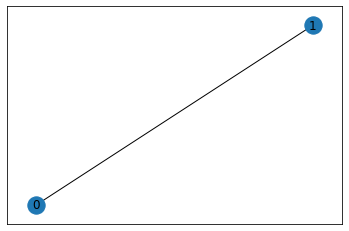
We define a function that creates our circuit
def createCircuit(x, G, depth):
V = list(G.nodes)
num_V = len(V)
q = QuantumRegister(num_V)
c = ClassicalRegister(num_V)
circ = QuantumCircuit(q, c)
# uniform superposition
circ.h(range(num_V))
circ.barrier()
for d in range(depth):
gamma = x[2 * d]
beta = x[2 * d + 1]
# go through all edges and add Rzz gate
for edge in G.edges():
i = int(edge[0])
j = int(edge[1])
w = G[i][j]["weight"]
circ.cx(q[i], q[j])
circ.rz(w * gamma, q[j])
circ.cx(q[i], q[j])
circ.barrier()
# add the mixer
circ.rx(2 * beta, range(num_V))
circ.barrier()
circ.measure(q, c)
return circ
draw example circuits
createCircuit(np.array((np.pi, np.pi)), G, 1).draw(output="mpl")

createCircuit(np.array((np.pi, np.pi, 1, 2)), G, 2).draw(output="mpl")

in order to evaluate a solution we define a function that gives us the cost
def cost(x, G):
C = 0
for edge in G.edges():
i = int(edge[0])
j = int(edge[1])
w = G[i][j]["weight"]
C = C + w / 2 * (1 - (2 * x[i] - 1) * (2 * x[j] - 1))
return C
brute force function that lists all 2^n possibilities and finds the best solutions (use with caution)
def listcosts(G):
costs = {}
maximum = 0
solutions = []
V = list(G.nodes)
num_V = len(V)
for i in range(2**num_V):
binstring = "{0:b}".format(i).zfill(num_V)
y = [int(i) for i in binstring]
costs[binstring] = cost(y, G)
maximum = max(maximum, costs[binstring])
for key in costs:
if costs[key] == maximum:
solutions.append(key)
return costs, maximum, solutions
listcosts(G)
({'00': 0.0, '01': 1.0, '10': 1.0, '11': 0.0}, 1.0, ['01', '10'])
the result of a circuit contains a dictionary containing bitstrings together with how many times they have occured
we define a function that gives us (an approximation of) the expectationvalue based on this
def expectationValue(data, G):
res = data.result().results
E = []
V = list(G.nodes)
num_V = G.number_of_nodes()
for result in res:
n_shots = result.shots
counts = result.data.counts
e = 0
for hexkey in list(counts.keys()):
count = counts[hexkey]
binstring = "{0:b}".format(int(hexkey, 0)).zfill(num_V)
y = [int(i) for i in binstring]
e += cost(y, G) * count / n_shots
E.append(-e)
return E
we will use an ideal simulator
ideal_sim = Aer.get_backend("qasm_simulator")
to get the energy/training/cost landscape for depth p=1, we sample the region \([0,\frac{\pi}{2}]^2\)
circuits = []
n = 16
for gamma in np.linspace(0, np.pi, n):
for beta in np.linspace(0, np.pi, n):
circuits.append(createCircuit(np.array((gamma, beta)), G, 1))
job_sim = execute(circuits, ideal_sim, shots=1024 * 2 * 2 * 2)
val = expectationValue(job_sim, G)
E = np.array(val).reshape(n, n)
f = pl.figure(figsize=(6, 6), dpi=80, facecolor="w", edgecolor="k")
_ = pl.xlabel(r"$\gamma$")
_ = pl.ylabel(r"$\beta$")
ax = pl.gca()
im = ax.imshow(E, interpolation="bicubic", origin="lower", extent=[0, np.pi, 0, np.pi])
divider = make_axes_locatable(ax)
cax = divider.append_axes("right", size="5%", pad=0.05)
_ = pl.colorbar(im, cax=cax)
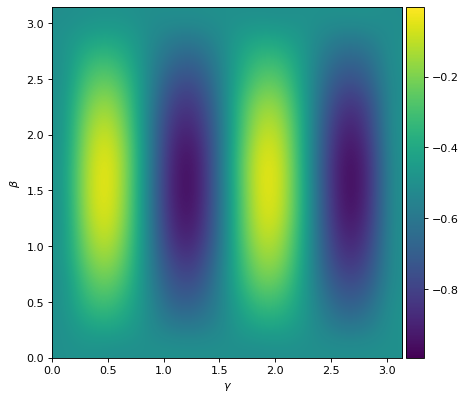
we import minimizers from scipy to do local minimization
from scipy import optimize as opt
the minimize funciton needs a function to evalution, which we create next
def getval(x, backend):
circ = createCircuit(x, G, 1)
tcirc = transpile(circ, backend)
j = execute(tcirc, backend, shots=1024 * 2 * 2 * 2)
val = expectationValue(j, G)
return val[0]
out = opt.minimize(
getval,
x0=(1, 1),
method="Nelder-Mead",
args=(ideal_sim),
options={"xatol": 1e-2, "fatol": 1e-2, "disp": True},
)
Optimization terminated successfully.
Current function value: -1.000000
Iterations: 18
Function evaluations: 36
f = pl.figure(figsize=(6, 6), dpi=80, facecolor="w", edgecolor="k")
_ = pl.xlabel(r"$\beta$")
_ = pl.ylabel(r"$\gamma$")
ax = pl.gca()
im = ax.imshow(E, interpolation="bicubic", origin="lower", extent=[0, np.pi, 0, np.pi])
_ = pl.plot(out.x[1], out.x[0], "xr")
divider = make_axes_locatable(ax)
cax = divider.append_axes("right", size="5%", pad=0.05)
_ = pl.colorbar(im, cax=cax)
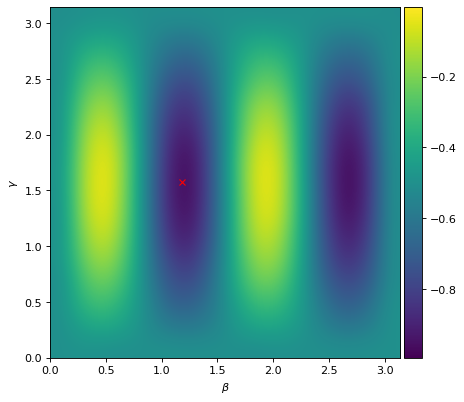
let’s plot the histogram
j = execute(createCircuit(out.x, G, 1), ideal_sim, shots=1024 * 2 * 2 * 2)
plot_histogram(j.result().get_counts())
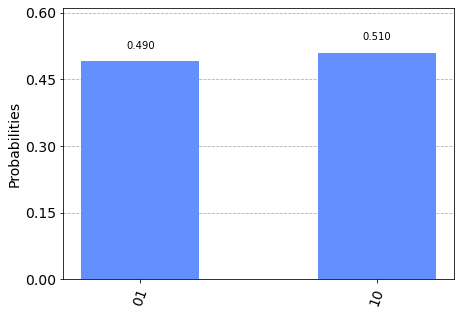
next, let’s see the effect of noise
we use a backend that emulates a real device “Vigo”
from qiskit.providers.aer import AerSimulator
from qiskit.test.mock import FakeVigo
device_backend = FakeVigo()
sim_vigo = AerSimulator.from_backend(device_backend)
plot_error_map(FakeVigo())
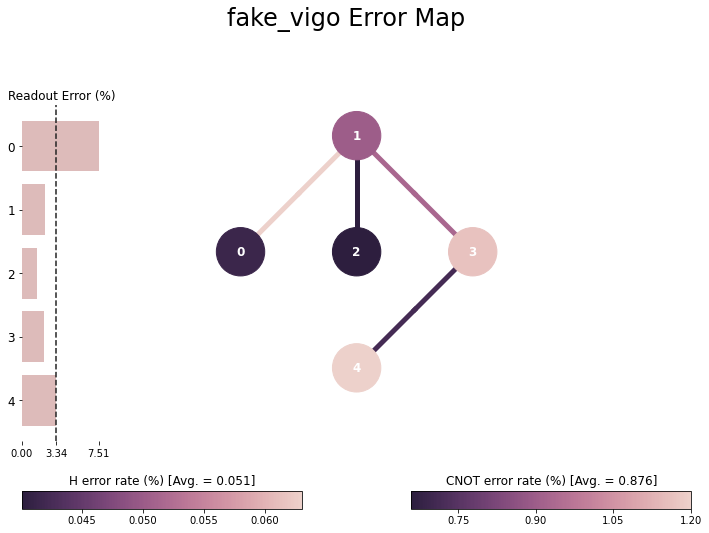
again, we sample the energy/training/cost landscape for depth p=1
noisy_circuits = []
n = 16
for gamma in np.linspace(0, np.pi, n):
for beta in np.linspace(0, np.pi, n):
circ = createCircuit(np.array((gamma, beta)), G, 1)
# we need to transpile the circuit for the backend
tcirc = transpile(circ, sim_vigo)
noisy_circuits.append(tcirc)
job_sim_noise = execute(noisy_circuits, sim_vigo, shots=1024 * 2 * 2 * 2)
val_noise = expectationValue(job_sim_noise, G)
E_noise = np.array(val_noise).reshape(n, n)
we can now compare the landscape from the ideal and noisy simulation
(the circuit consist of only 2 qubits and 2 cnot gates)
f, axarr = pl.subplots(1, 2, figsize=(10, 10), dpi=80, facecolor="w", edgecolor="k")
vmin = min(np.min(E), np.min(E_noise))
vmax = min(np.max(E), np.max(E_noise))
_ = axarr[0].imshow(E, vmin=vmin, vmax=vmax, origin="lower", extent=[0, np.pi, 0, np.pi])
_ = axarr[1].imshow(
E_noise, vmin=vmin, vmax=vmax, origin="lower", extent=[0, np.pi, 0, np.pi]
)
for i in range(2):
_ = axarr[i].set_xlabel(r"$\beta$")
_ = axarr[i].set_ylabel(r"$\gamma$")
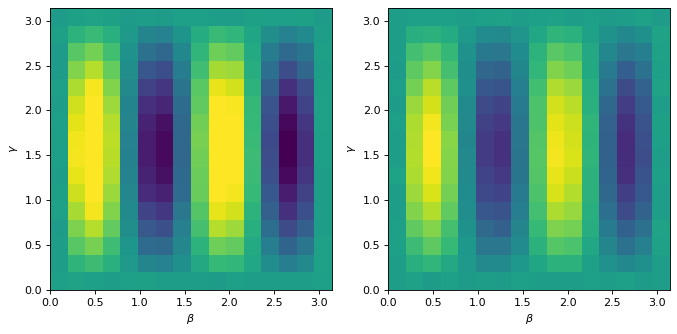
out_noise = opt.minimize(
getval,
x0=(1, 1),
args=(sim_vigo),
method="Nelder-Mead",
options={"xatol": 1e-2, "fatol": 1e-2, "disp": True},
)
Optimization terminated successfully.
Current function value: -0.894897
Iterations: 20
Function evaluations: 48
f, axarr = pl.subplots(1, 2, figsize=(10, 10), dpi=80, facecolor="w", edgecolor="k")
vmin = min(np.min(E), np.min(E_noise))
vmax = min(np.max(E), np.max(E_noise))
_ = axarr[0].imshow(
E,
vmin=vmin,
vmax=vmax,
origin="lower",
extent=[0, np.pi, 0, np.pi],
interpolation="bicubic",
)
_ = axarr[1].imshow(
E_noise,
vmin=vmin,
vmax=vmax,
origin="lower",
extent=[0, np.pi, 0, np.pi],
interpolation="bicubic",
)
_ = axarr[0].plot(out.x[1], out.x[0], "xr")
_ = axarr[1].plot(out_noise.x[1], out_noise.x[0], "ok")
for i in range(2):
_ = axarr[i].set_xlabel(r"$\beta$")
_ = axarr[i].set_ylabel(r"$\gamma$")
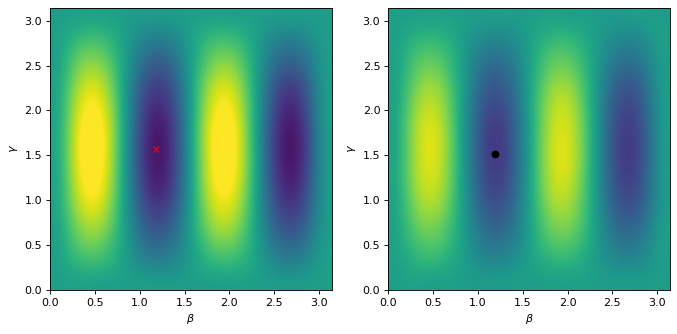
let’s plot the histogram. How did the noise effect it?
circ = createCircuit(out_noise.x, G, 1)
tcirc = transpile(circ, sim_vigo)
j = execute(tcirc, sim_vigo, shots=1024 * 2 * 2 * 2)
plot_histogram(j.result().get_counts())
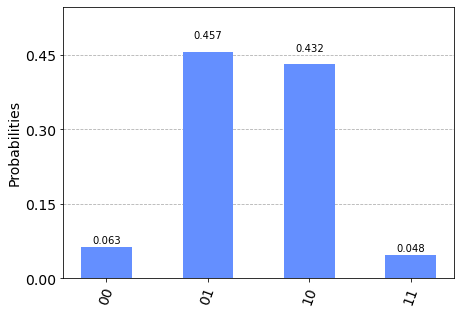
finally, let’s create a larger circuit
V = np.arange(0, 5, 1)
E = [(0, 1, 1.0), (0, 2, 1.0), (2, 3, 1.0), (3, 1, 1.0), (3, 4, 1.0), (4, 2, 1.0)]
G = nx.Graph()
G.add_nodes_from(V)
G.add_weighted_edges_from(E)
nx.draw_networkx(G)
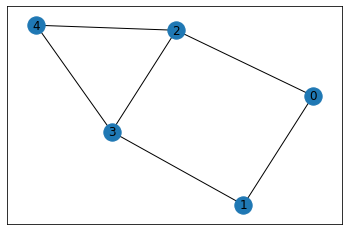
what are the solutions?
l, m, maxcost = listcosts(G)
print(m, maxcost)
5.0 ['01100', '01101', '10010', '10011']
how does the circuit look?
createCircuit(np.array((0.4, 0.1)), G, 1).draw(output="mpl")
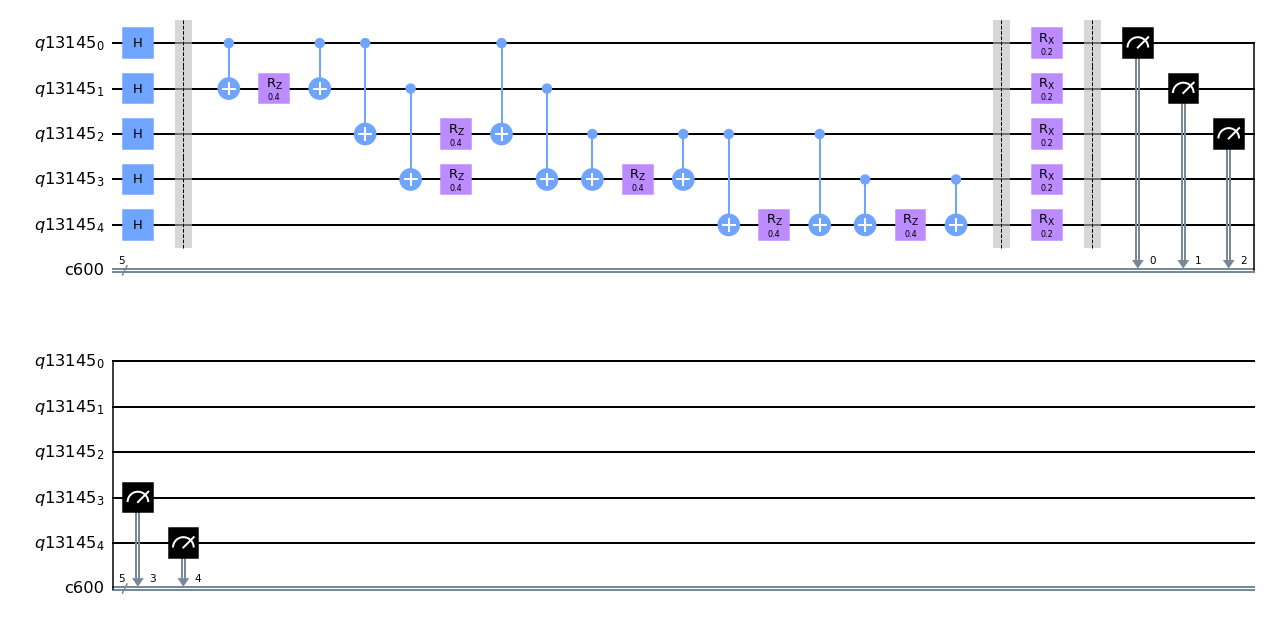
how does the circuit look on a real device?
plot_gate_map(FakeVigo())
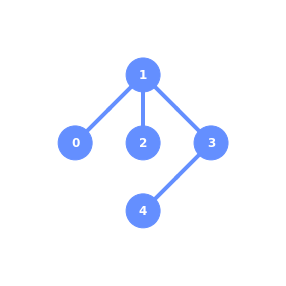
transpile(createCircuit(np.array((0.4, 0.1)), G, 1), backend=sim_vigo).draw(output="mpl")

create energy landscapes for ideal and noisy simulations
circuits = []
n = 16
for gamma in np.linspace(0, np.pi, n):
for beta in np.linspace(0, np.pi, n):
circ = createCircuit(np.array((gamma, beta)), G, 1)
circuits.append(circ)
job_sim = execute(circuits, ideal_sim, shots=1024 * 2 * 2 * 2)
val = expectationValue(job_sim, G)
E = np.array(val).reshape(n, n)
noisy_circuits = []
n = 16
for gamma in np.linspace(0, np.pi, n):
for beta in np.linspace(0, np.pi, n):
circ = createCircuit(np.array((gamma, beta)), G, 1)
# we need to transpile the circuit for the backend
tcirc = transpile(circ, sim_vigo)
noisy_circuits.append(tcirc)
job_sim_noisy = execute(noisy_circuits, sim_vigo, shots=1024 * 2 * 2 * 2)
val_noisy = expectationValue(job_sim_noisy, G)
E_noise = np.array(val_noisy).reshape(n, n)
a comparison of the energy landscapes
f, axarr = pl.subplots(1, 2, figsize=(10, 10), dpi=80, facecolor="w", edgecolor="k")
vmin = min(np.min(E), np.min(E_noise))
vmax = min(np.max(E), np.max(E_noise))
_ = axarr[0].imshow(
E,
vmin=vmin,
vmax=vmax,
origin="lower",
extent=[0, np.pi, 0, np.pi],
interpolation="bicubic",
)
_ = axarr[1].imshow(
E_noise,
vmin=vmin,
vmax=vmax,
origin="lower",
extent=[0, np.pi, 0, np.pi],
interpolation="bicubic",
)
# _=axarr[0].plot(out.x[1],out.x[0],'xr')
# _=axarr[1].plot(out_noise.x[1],out_noise.x[0],'ok')
for i in range(2):
_ = axarr[i].set_xlabel(r"$\beta$")
_ = axarr[i].set_ylabel(r"$\gamma$")
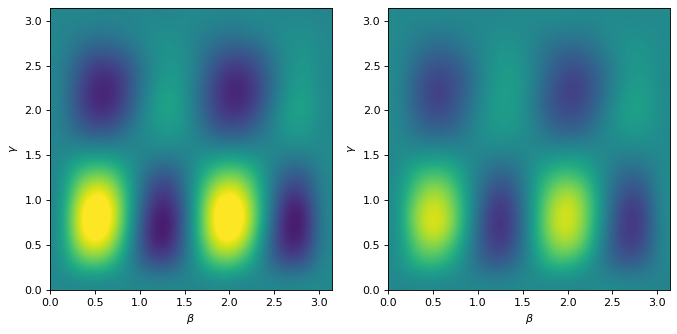
histograms of the best solution at depth p=1
out = opt.minimize(
getval,
x0=(1, 1),
args=(ideal_sim),
method="Nelder-Mead",
options={"xatol": 1e-2, "fatol": 1e-2, "disp": True},
)
circ = createCircuit(out.x, G, 1)
j = execute(circ, ideal_sim, shots=1024 * 2 * 2 * 2)
plot_histogram(j.result().get_counts())
Optimization terminated successfully.
Current function value: -3.890503
Iterations: 14
Function evaluations: 28
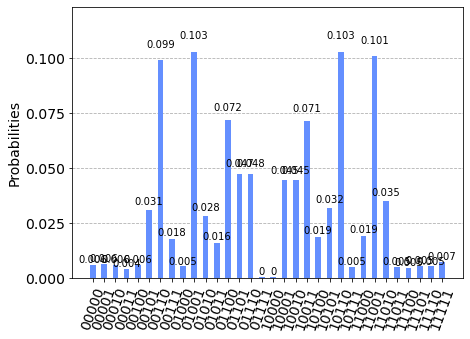
out_noise = opt.minimize(
getval,
x0=(1, 1),
args=(sim_vigo),
method="Nelder-Mead",
options={"xatol": 1e-2, "fatol": 1e-2, "disp": True},
)
circ = createCircuit(out_noise.x, G, 1)
tcirc = transpile(circ, sim_vigo)
j = execute(tcirc, sim_vigo, shots=1024 * 2 * 2 * 2)
plot_histogram(j.result().get_counts())
Warning: Maximum number of function evaluations has been exceeded.

Where to go next? Try increasing the depth…
